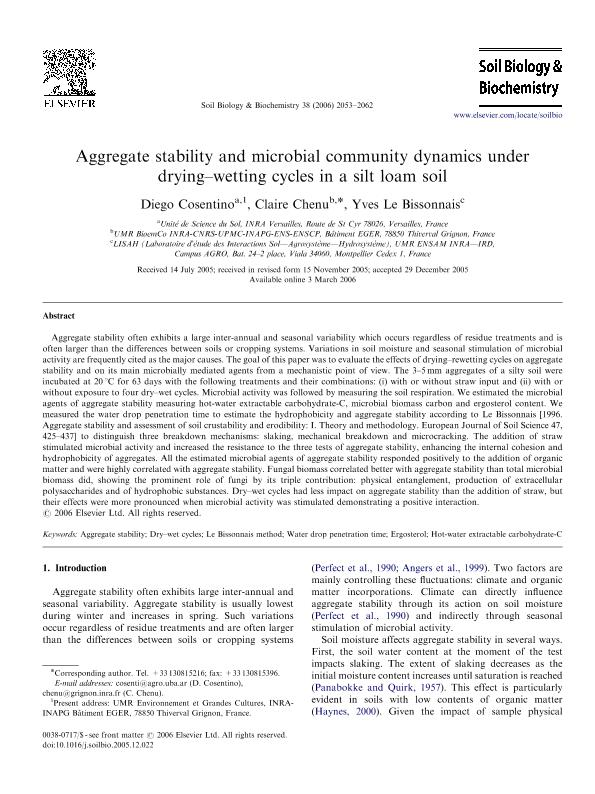Mostrar el registro sencillo del ítem
dc.contributor.author
Cosentino, Diego

dc.contributor.author
Chenu, Clarie
dc.contributor.author
Le Bissonnais, Ives
dc.date.available
2017-05-17T20:53:09Z
dc.date.issued
2006-12
dc.identifier.citation
Cosentino, Diego; Chenu, Clarie; Le Bissonnais, Ives; Aggregate stability and microbial community dynamics under drying-wetting cycles in a silt loam soil; Elsevier; Soil Biology And Biochemistry; 38; 8; 12-2006; 2053-2062
dc.identifier.issn
0038-0717
dc.identifier.uri
http://hdl.handle.net/11336/16613
dc.description.abstract
Aggregate stability often exhibits a large inter-annual and seasonal variability which occurs regardless of residue treatments and is often larger than the differences between soils or cropping systems. Variations in soil moisture and seasonal stimulation of microbial activity are frequently cited as the major causes. The goal of this paper was to evaluate the effects of drying–rewetting cycles on aggregate stability and on its main microbially mediated agents from a mechanistic point of view. The 3–5 mm aggregates of a silty soil were incubated at 20 °C for 63 days with the following treatments and their combinations: (i) with or without straw input and (ii) with or without exposure to four dry–wet cycles. Microbial activity was followed by measuring the soil respiration. We estimated the microbial agents of aggregate stability measuring hot-water extractable carbohydrate-C, microbial biomass carbon and ergosterol content. We measured the water drop penetration time to estimate the hydrophobicity and aggregate stability according to Le Bissonnais [1996. Aggregate stability and assessment of soil crustability and erodibility: I. Theory and methodology. European Journal of Soil Science 47, 425–437] to distinguish three breakdown mechanisms: slaking, mechanical breakdown and microcracking. The addition of straw stimulated microbial activity and increased the resistance to the three tests of aggregate stability, enhancing the internal cohesion and hydrophobicity of aggregates. All the estimated microbial agents of aggregate stability responded positively to the addition of organic matter and were highly correlated with aggregate stability. Fungal biomass correlated better with aggregate stability than total microbial biomass did, showing the prominent role of fungi by its triple contribution: physical entanglement, production of extracellular polysaccharides and of hydrophobic substances. Dry–wet cycles had less impact on aggregate stability than the addition of straw, but their effects were more pronounced when microbial activity was stimulated demonstrating a positive interaction.
dc.format
application/pdf
dc.language.iso
eng
dc.publisher
Elsevier

dc.rights
info:eu-repo/semantics/openAccess
dc.rights.uri
https://creativecommons.org/licenses/by-nc-nd/2.5/ar/
dc.subject.classification
Ciencias del Suelo

dc.subject.classification
Agricultura, Silvicultura y Pesca

dc.subject.classification
CIENCIAS AGRÍCOLAS

dc.title
Aggregate stability and microbial community dynamics under drying-wetting cycles in a silt loam soil
dc.type
info:eu-repo/semantics/article
dc.type
info:ar-repo/semantics/artículo
dc.type
info:eu-repo/semantics/publishedVersion
dc.date.updated
2017-05-16T20:36:29Z
dc.journal.volume
38
dc.journal.number
8
dc.journal.pagination
2053-2062
dc.journal.pais
Países Bajos

dc.journal.ciudad
Amsterdam
dc.description.fil
Fil: Cosentino, Diego. Institut National de la Recherche Agronomique; Francia. Consejo Nacional de Investigaciones Científicas y Técnicas. Oficina de Coordinación Administrativa Parque Centenario; Argentina
dc.description.fil
Fil: Chenu, Clarie. Institut National de la Recherche Agronomique; Francia
dc.description.fil
Fil: Le Bissonnais, Ives. Institut National de la Recherche Agronomique; Francia
dc.journal.title
Soil Biology And Biochemistry

dc.relation.alternativeid
info:eu-repo/semantics/altIdentifier/url/http://www.sciencedirect.com/science/article/pii/S0038071706000848
dc.relation.alternativeid
info:eu-repo/semantics/altIdentifier/doi/http://dx.doi.org/10.1016/j.soilbio.2005.12.022
Archivos asociados
